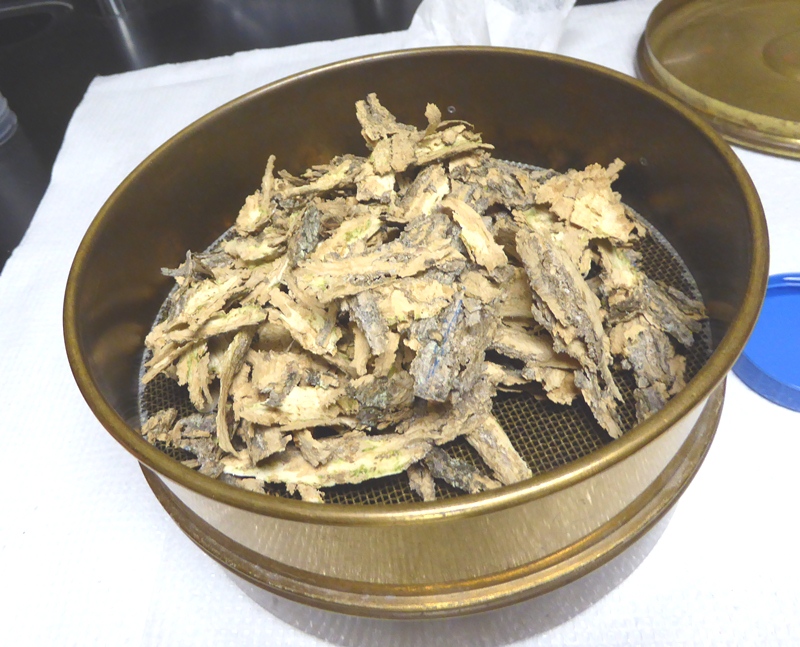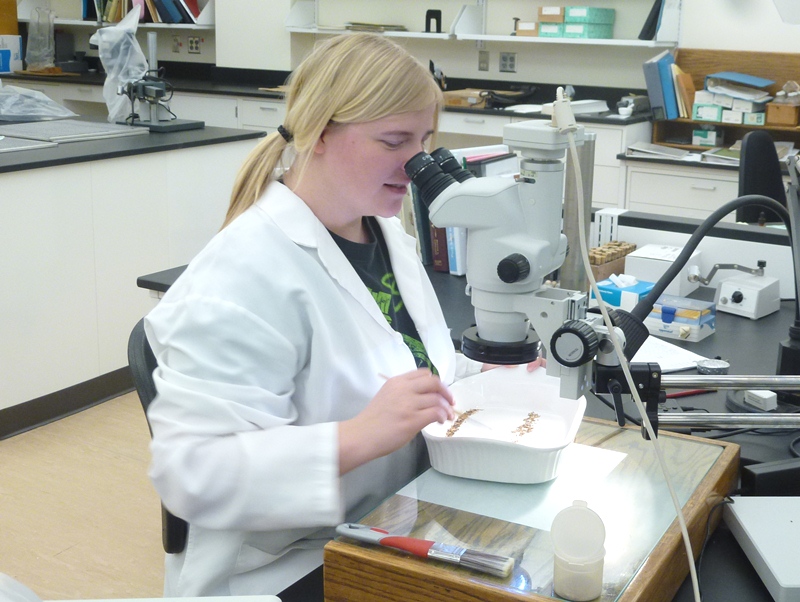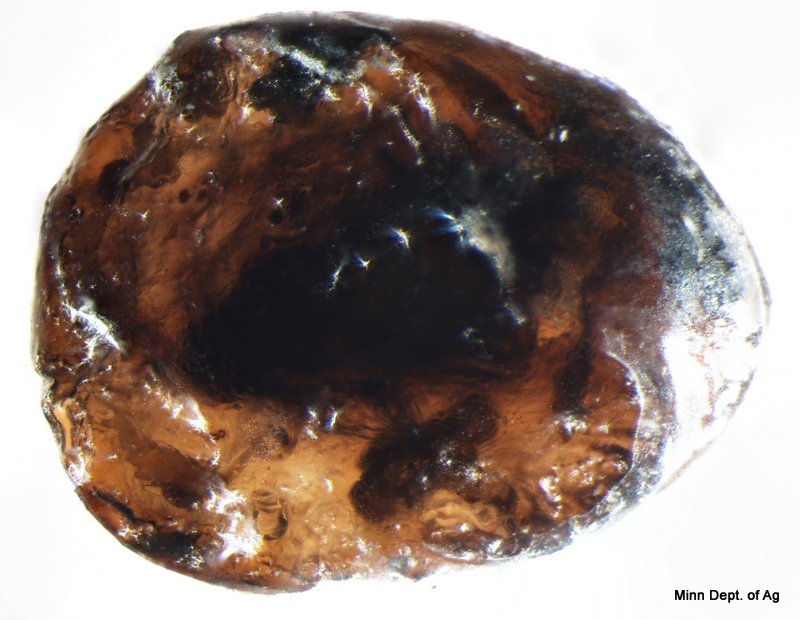This method of parasitoid recovery is the most labor intensive and requires the felling of branches or entire trees. Bark is removed in thin layers down to the cambium where EAB larval galleries and intact larvae are documented, collected and examined for evidence of parasitism.
Branches are peeled then examined
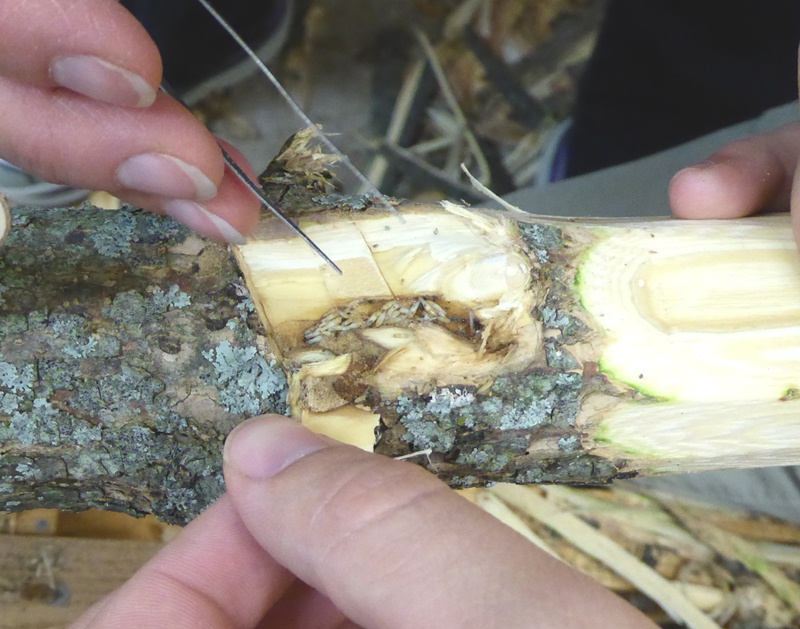
Immature Tetrastichus planipennisi in an EAB gallery
A method used in conjunction with tree debarking. All intact EAB larvae with no outward signs of parasitism are collected during the process. Larvae are then dissected under a microscope to look for internal immature wasp larvae. The rear end of the insect is removed with a surgical scissors and the innards are pushed out into droplets of water. If the EAB larva is parasitized, the wasp larva(e) will float to the surface.
A method used in conjunction with tree debarking. All intact EAB larvae with no outward signs of parasitism are collected during the process. Larvae are then dissected under a microscope to look for internal immature wasp larvae. The rear end of the insect is removed with a surgical scissors and the innards are pushed out into droplets of water. If the EAB larva is parasitized, the wasp larva(e) will float to the surface.
A method used in conjunction with tree debarking. All intact EAB larvae with no outward signs of parasitism are collected during the process. Larvae are then dissected under a microscope to look for internal immature wasp larvae. The rear end of the insect is removed with a surgical scissors and the innards are pushed out into droplets of water. If the EAB larva is parasitized, the wasp larva(e) will float to the surface.
This method was devised by Dr. Leah Bauer with the USDA Forest Service Northern Research Station in Lansing, MI. A 10 x 50cm section of outer bark is scraped off the trunk of an infested ash tree using a drawknife. The bark is collected by a plastic sheet laid at the base of the tree and then transferred to a paper bag to dry out and avoid the growth of mold while in storage. After the bark has dried for a month, the sample is placed into a sieve and shook for two minutes. Once done sieving the sample, the fine debris is transferred to a ceramic dish and analyzed underneath a dissecting microscope for the presence of parasitized EAB eggs.
This method was devised by Dr. Leah Bauer with the USDA Forest Service Northern Research Station in Lansing, MI. A 10 x 50cm section of outer bark is scraped off the trunk of an infested ash tree using a drawknife. The bark is collected by a plastic sheet laid at the base of the tree and then transferred to a paper bag to dry out and avoid the growth of mold while in storage. After the bark has dried for a month, the sample is placed into a sieve and shook for two minutes. Once done sieving the sample, the fine debris is transferred to a ceramic dish and analyzed underneath a dissecting microscope for the presence of parasitized EAB eggs.
This method was devised by Dr. Leah Bauer with the USDA Forest Service Northern Research Station in Lansing, MI. A 10 x 50cm section of outer bark is scraped off the trunk of an infested ash tree using a drawknife. The bark is collected by a plastic sheet laid at the base of the tree and then transferred to a paper bag to dry out and avoid the growth of mold while in storage. After the bark has dried for a month, the sample is placed into a sieve and shook for two minutes. Once done sieving the sample, the fine debris is transferred to a ceramic dish and analyzed underneath a dissecting microscope for the presence of parasitized EAB eggs.
A method used to collect adult parasitoids by use of pan traps. Yellow bowls are affixed to the trunks of ash trees with shelving brackets and filled with a clear propylene glycol solution. This liquid traps insects that are attracted to the yellow color of the bowl. Traps are sampled weekly throughout the summer. Samples are poured through a filter, frozen and screened for parasitoids in the late fall.
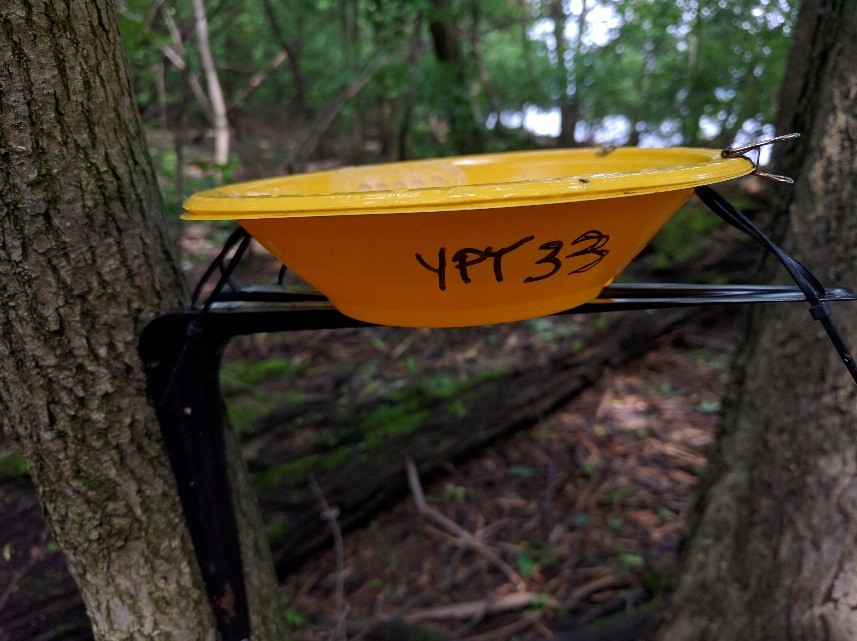
A method used to collect adult parasitoids by use of pan traps. Yellow bowls are affixed to the trunks of ash trees with shelving brackets and filled with a clear propylene glycol solution. This liquid traps insects that are attracted to the yellow color of the bowl. Traps are sampled weekly throughout the summer. Samples are poured through a filter, frozen and screened for parasitoids in the late fall.

A method used to collect adult parasitoids by use of pan traps. Yellow bowls are affixed to the trunks of ash trees with shelving brackets and filled with a clear propylene glycol solution. This liquid traps insects that are attracted to the yellow color of the bowl. Traps are sampled weekly throughout the summer. Samples are poured through a filter, frozen and screened for parasitoids in the late fall.

